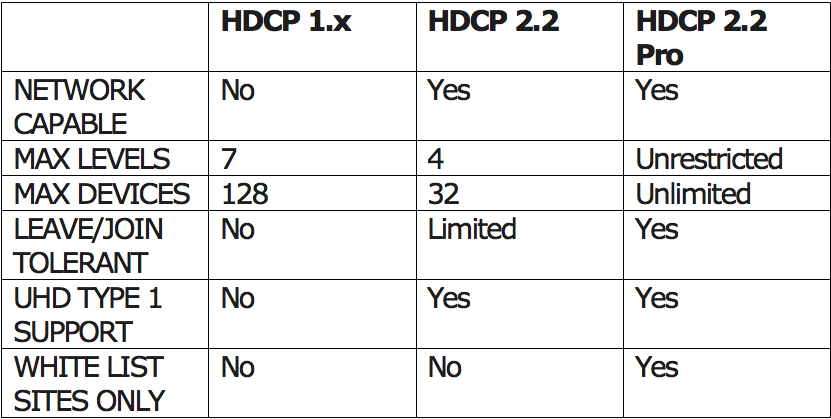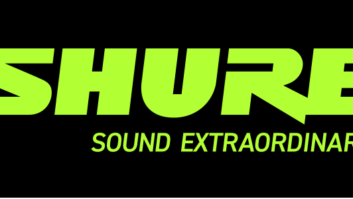
HDCP 2.2 Professional enables wider distribution of protected content – with some obligations for integrators, says Chuck Van Dusen, video systems architect at Biamp Systems.
HDCP (High-bandwidth Digital Content Protection) was created to prevent valuable content, such as 4K theatrical titles, from being copied as it travels between connections in a local network or a point-to-point system. Within the pro-AV world, the need to distribute high-level content only arises occasionally; however, some laptops and tablets, and nearly all Blu-ray Disc players, output HDCP-protected content by default.
An overarching challenge for AV integrators and consultants are design requirements that exceed the HDCP 2.2 specifications. DCP – the Intel-owned body that develops and administers HDCP – has recognised some of the hurdles facing our industry and has produced a version that is better suited for professional AV distribution.
For background, HDCP 1.4 supports a total of 128 devices and seven levels of connection (but does not support transmission of protected content over networks), while HDCP 2.2 supports a limit of 32 devices and four levels.

Previewed earlier this year, HDCP 2.2 Professional joins HDCP 1.4 and HDCP 2.2 as another licensed standard. HDCP 2.2 Pro builds on ‘regular’ 2.2 and removes the topology limits on levels and maximum devices, but with some additional constraints.
Whitelisted locations
First, the installer must be licensed with DCP. Second, the system must be installed in an authorised location: DCP maintains a ‘whitelist’ of facility types approved for 2.2 Pro systems, including shopping malls, airports, educational facilities, cruise ships, and 20 other categories. Licensed installers, ‘Adopters’ (such as manufacturers) and resellers may petition DCP to extend this list.
Each item of HDCP-protected media contains an SRM (system renewability message) – a data file containing a ‘revocation list’ of device IDs that DCP does not allow protected content to be sent to (in most cases because the devices have been compromised). A media player sending content to a repeater or directly to an end display will update its own stored SRM if it receives a newer one, and check all the device IDs in the connected topology against the SRM before content will play.
To comply with HDCP 2.2 Pro, an installed system must use an ‘HDCP Professional Repeater’. This repeater contains its own internal SRM engine that can verify the authorisation status of every device connected below it, so it will report up to the media source as a device count of 1 and a level count of 1. This is how HDCP 2.2 Professional removes the topology limits of prior specifications, and relaxes the constraint on the number of supported HDCP keys in the media player itself.
DCP updates the SRM four times a year, and it is a condition of the HDCP 2.2 Pro licence that the SRMs in professional repeaters must be updated at least once a quarter. If the update does not take place and the system detects an SRM that is more than three months old, the repeater’s functionality changes to ‘regular’ HDCP 2.2 – reinstating the topology limits (four levels, 32 devices) until an up-to-date SRM is provided. If a Professional Repeater has internet access, the SRM can be updated by accessing a URL maintained by the DCP and downloading the latest version.
The HDCP 2.2 Pro specification also allows for ‘Exempt HDCP Professional Repeaters’, which are not bound by this quarterly obligation but may download at a different, DCP-approved schedule. Additional work on this facet of the specification is ongoing.
No workarounds
In the recent past, some manufacturers have ‘worked around’ the limitations of HDCP 1.4 and 2.2; for instance, by producing equipment that generates additional device keys. It’s quite possible that DCP will become less lenient about systems that circumvent its standards now that it has catered to the professional user base with 2.2 Pro. It has already shown it is prepared to take legal action, having sued several manufacturers, one such suit resulting in a $5 million-plus settlement.
In summary, HDCP 2.2 Pro requires a little more work from installers – both in terms of paperwork and managing SRM updates – in exchange for the benefits of unlimited fan-out, but that’s better than being denied access to content in large deployments. It’s not something you should ignore, especially considering that HDCP specifications will continue to evolve.
Audiovisual professionals can find some more information about HDCP 2.2 Pro on DCP’s website: http://bit.ly/2bhjhGP







